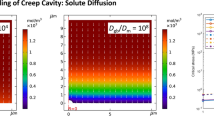Abstract
Two models of constrained cavity growth are developed to describe the long-term longitudinal creep behavior of nickel based oxide dispersion strengthened (ODS) alloys. For both models the rupture time is taken as the time for a transverse grain boundary to cavitate fully. A diffusive cavity growth law is assumed to govern cavitation. The applicability of the respective models is determined by the particular grain morphology achieved by thermal-mechanical processing. The first model assumes that longitudinal grain boundaries are unable to slide; hence displacements due to cavitation must be matched by displacements due to dislocation creep in adjoining grains. This model predicts a low stress exponent at the transition from single crystal to cavitation creep behavior, and higher stress exponents at stresses below this transition. Good agreement is found between the model predictions and creep data for MA 754 at 1000 and 1093 °C. A second model considers a grain morphology wherein longitudinal grain boundaries are able to slide by means of deformation of pockets of fine grains. Cavitation of transverse grain boundaries is thus controlled by grain boundary sliding. This model predicts a stress exponent of 1 at low stresses, and serves as an upper bound for the creep rate when a duplex grain morphology is present. Model predictions are in good agreement with creep data for a heat of MA 754 with a duplex grain morphology.
Similar content being viewed by others
References
W. Crawford: “Oxide Dispersion Strengthened Materials in Advanced Gas Turbine Engines — MA 754 Vanes” inFrontiers of High Tem- perature Materials II, J. S. Benjamin, ed., INCO Alloy Products Co., New York, NY, 1983.
A.J.E. Foreman and M.J. Makin:Phil. Mag., 1966, vol. 13, pp. 911–24.
U.F. Kocks:Phil. Mag., 1966, vol. 13, pp. 541–66.
R. W. Lund and W. D. Nix:Acta Metall., 1976, vol. 24, pp. 469–81.
B.A. Wilcox and A. H. Clauer:Acta Metall., 1972, vol. 20, pp. 743–57.
R. L. Cairns, L. R. Curwick, and J.S. Benjamin:Metall. Trans. A, 1975, vol. 6A, pp. 179–88.
J.D. Whittenberger:Materials Science and Engineering, 1982, vol. 54, pp. 81–83.
J.J. Stephens and W. D. Nix: “Creep and Fracture of Inconel MA 754” inProceedings of the Fifth International Symposium on Superalloys, M. Gell, ed., AIME, New York, NY, 1984, pp. 327–34.
J.D. Whittenberger:Metall. Trans. A, 1977, vol. 8A, pp. 1155–63.
T. E. Howson, J. K. Howson, and J. K. Tien:Metall. Trans. A, 1980, vol. 11A, pp. 1599–1607.
J.J. Stephens and W.D. Nix:Metall. Trans. A, 1985, vol. 16A, pp. 1307–24.
D. Hull and D.E. Rimmer:Phil. Mag., 1959, vol. 4, pp. 673–87.
W. D. Nix and J. C. Gibeling: “Mechanisms of Time-Dependent Flow and Fracture of Metals”, inFlow and Fracture at Elevated Temperatures, R. Raj, ed., ASM, Metals Park, OH, 1984.
B.F. Dyson:Metal Science, 1976, vol. 10, pp. 349–53.
J.R. Rice:Acta Metall., 1981, vol. 29, pp. 675–81.
R. Raj and A. K. Ghosh:Metall. Trans. A, 1981, vol. 12A, pp. 1291–1302.
J. J. Stephens and S. Spooner: Acta Metall., 1986, vol. 34, in press.
R.K. Varma and B.F. Dyson:Scripta Metall., 1982, vol. 16, pp. 1279–84.
A. Needleman and J.R. Rice:Acta Metall., 1980, vol. 28, pp. 1315–32.
W.D. Nix, K. S. Yu, and J.S. Wang:Metall. Trans. A, 1983, vol. 14A, pp. 563–70.
M. F. Rothman and H. M. Tawancey: “Effect of TMP Variables upon Structure and Properties in ODS Alloy HDA 8077 Sheet,” inSuper- alloys 1980, J.K. Tien, ed., ASM, Metals Park, OH, 1980, pp. 179–88.
Author information
Authors and Affiliations
Additional information
Formerly Graduate Research Assistant in the Department of Materials Science and Engineering at Stanford University
Rights and permissions
About this article
Cite this article
Stephens, J.J., Nix, W.D. Constrained cavity growth models of longitudinal creep deformation of oxide dispersion strengthened alloys. Metall Trans A 17, 281–293 (1986). https://doi.org/10.1007/BF02643904
Received:
Issue Date:
DOI: https://doi.org/10.1007/BF02643904




